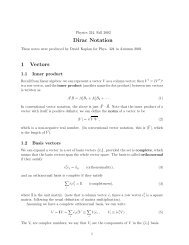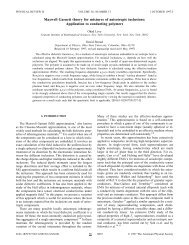Information for Physics 1201 Midterm 2 Wednesday, March 27
Information for Physics 1201 Midterm 2 Wednesday, March 27
Information for Physics 1201 Midterm 2 Wednesday, March 27
You also want an ePaper? Increase the reach of your titles
YUMPU automatically turns print PDFs into web optimized ePapers that Google loves.
My lecture slides are posted at<br />
http://www.physics.ohio-state.edu/~humanic/<br />
<strong>In<strong>for</strong>mation</strong> <strong>for</strong> <strong>Physics</strong> <strong>1201</strong> <strong>Midterm</strong> 2<br />
<strong>Wednesday</strong>, <strong>March</strong> <strong>27</strong><br />
1) Format: 10 multiple choice questions (each worth 5 points) and<br />
two show-work problems (each worth 25 points), giving 100 points<br />
total.<br />
2) Closed book and closed notes.<br />
3) Equations and constants will be provided on the midterm<br />
4) Covers the material in Chapters 21, 22, 23, and 24
Polarization<br />
Polarized light is produced by the scattering of unpolarized<br />
sunlight by molecules in the atmosphere.<br />
Molecules re-radiate sunlight.<br />
As you look at larger and larger<br />
angles with respect to the<br />
incident sunlight, the re-radiated<br />
light becomes more and more<br />
horizontally polarized.
Polaroid Sun Glasses<br />
Besides sunlight re-radiated from atmospheric molecules, there are<br />
other sources of horizontally polarized light that occur in nature, such<br />
as sunlight reflected from horizontal surfaces such as lakes.<br />
Polaroid sun glasses take advantage of this fact by using polarizers<br />
with their axes oriented vertically:<br />
è in addition to 1/2 of the unpolarized light which is already blocked by<br />
the polarizers, all of the horizontally polarized light is completely blocked,<br />
thus blocking out some of the reflected light which can confuse you<br />
during some outdoor activities (e.g. driving, piloting, fishing…….).
Polarization<br />
Another application using polarized glasses: watching 3-D movies.<br />
In a 3-D movie, two separate rolls of film are projected using a projector<br />
with two lenses, each with its own polarizer. The two polarizers are<br />
crossed. Viewers watch the action on-screen through glasses that have<br />
correspondingly crossed polarizers <strong>for</strong> each eye.<br />
IMAX movie projector Movie viewer using polarized glasses
Example. Partially polarized and partially unpolarized light.<br />
A light beam passes through a polarizer whose transmission axis makes<br />
angle θ with the vertical. The beam is partially polarized and<br />
partially unpolarized, and the average intensity of the incident light,<br />
S 0 , is the sum of the average intensity of the polarized light, S 0,polar ,<br />
and the average intensity of the unpolarized light, S 0,unpolar .<br />
As the polarizer is rotated clockwise, the intensity of the transmitted light<br />
has a minimum value of 2.0 W/m 2 when θ = 20.0 o and has a maximum<br />
value of 8.0 W/m 2 when the angle is θ = θ max .<br />
è Find a) S 0,unpolar , and b) S 0,polar .<br />
Incident light<br />
S 0 = S 0,polar + S 0,unpolar<br />
Transmitted light<br />
S = S polar + S unpolar
Incident light<br />
S 0 = S 0,polar + S 0,unpolar<br />
Transmitted light<br />
S = S polar + S unpolar<br />
a) Minimum transmitted intensity S = S min = 2.0 W/m 2 at θ = 20.0 o .<br />
S is minimum when S polar = 0 since S unpolar is not effected by θ.<br />
S unpolar = S min - S polar = 2.0 - 0 = 2.0 W/m 2<br />
S unpolar = ½ S 0,unpolar è S 0,unpolar = 2S unpolar = 2(2.0) = 4.0 W/m 2<br />
b) Maximum transmitted intensity S = S max = 8.0 W/m 2 occurs at θ max .<br />
S is maximum when S polar = S 0,polar (when θ = 20 o + 90 o = 110 o = θ max )<br />
S max = S 0,polar + S unpolor è S 0,polar = S max - S unpolar = 8.0 - 2.0 = 6.0 W/m 2
Polarization and the Reflection and Refraction of Light<br />
For air/water<br />
interface:<br />
θ p<br />
θ p<br />
n 1 =1.00, n 2 =1.33 ⇒ θ p = tan −1 1.33<br />
n 1 sinθ p = n 2 sinθ 2 ⇒ θ 2 = sin<br />
θ p +θ 2 = 90 o à Always true at θ p<br />
Reflected light is<br />
100% horizontally<br />
polarized at the<br />
polarizing angle, θ p<br />
Brewster’s law<br />
tanθ p = n 2<br />
n 1<br />
# &<br />
% ( = 53.1<br />
$ 1.00 '<br />
o<br />
−1 ( 1.00)sin53.1<br />
o<br />
)<br />
,<br />
+<br />
. = 36.9<br />
* 1.33 -<br />
o
Chapter 25<br />
Optical Instruments<br />
and the Eye
Cameras<br />
IMAGE FORMATION BY A CONVERGING LENS IN A CAMERA<br />
When the object is placed further than twice the focal length<br />
from the camera lens, the real image is inverted and smaller<br />
than the object on the film or ccd chip.
Cameras<br />
Example: Taking a picture of a flower vase with a ccd camera.<br />
A 0.500 m high flower vase is positioned 2.00 m in front of a ccd camera.<br />
The camera uses a converging lens whose focal length is 60.0 mm.<br />
(a) How far must the ccd be from the lens to have a sharp image?<br />
(b) Find the height of the image on the ccd.<br />
(c) If the lens diameter is 3.0 cm, find the f-stop of the lens.<br />
(d) If a properly exposed picture is taken with this f-stop with a shutter<br />
speed of 1/500 s, what f-stop is needed <strong>for</strong> a shutter speed of 1/125 s<br />
so that the picture is not overexposed?<br />
(a)<br />
(b)<br />
1<br />
d i<br />
= 1<br />
f<br />
− 1<br />
d o<br />
=<br />
1<br />
0.0600 m −<br />
d i = 0.0619 m = 61.9 mm<br />
h i = − d i<br />
d o<br />
h o = − 0.0619<br />
2.00<br />
1<br />
2.00 m<br />
=16.17 m−1<br />
0.500 = −0.0155 m = −15.5 mm
(c)<br />
f − stop =<br />
= 60 mm<br />
f<br />
Diameter of lens opening<br />
30 mm<br />
= 2.0 ⇒ f / 2<br />
= f<br />
D<br />
(d) For the picture not to be overexposed, we must reduce the lens area<br />
by the ratio of the shutter speeds, i.e.<br />
A final =<br />
!<br />
#<br />
"<br />
π D final<br />
2<br />
1 500<br />
1 125 Ainitial = 1<br />
4 Ainitial $<br />
&<br />
%<br />
2<br />
= 1<br />
f − stop final =<br />
!<br />
#<br />
4 π Dinitial " 2<br />
f<br />
D final<br />
= 2<br />
$<br />
&<br />
%<br />
2<br />
f<br />
D initial<br />
⇒ D final = 1<br />
2 D initial<br />
= 2( 2.0)<br />
= 4.0 ⇒ f / 4
The Human Eye<br />
ANATOMY
The Human Eye<br />
OPTICS<br />
The lens only contributes about 20-25% of the refraction, but its function<br />
is important.<br />
Normal eye near point, i.e. nearest point <strong>for</strong> com<strong>for</strong>table focusing, N = 25 cm<br />
Normal eye far point, i.e. farthest point <strong>for</strong> com<strong>for</strong>table focusing à ∞
The Human Eye<br />
NEARSIGHTEDNESS<br />
The lens creates an image of the distance object at the far point<br />
of the nearsighted eye.
The Human Eye<br />
Example: Eyeglasses <strong>for</strong> the Nearsighted Person<br />
A nearsighted person has a far point and near point located at only 10.0 cm<br />
and 8.0 cm, respectively, from the eye. Assuming that eyeglasses are to be<br />
worn 2.0 cm in front of the eye, find (a) the focal length needed <strong>for</strong> the lens<br />
of the glasses so the person can see distant objects and (b) the resulting<br />
location of the near point when the person is wearing these glasses.
The Human Eye<br />
(a)<br />
(b)<br />
do = ∞, di = −( 10.0 − 2.0)<br />
= −8.0 cm<br />
1<br />
f<br />
= 1<br />
d o<br />
+ 1<br />
d i<br />
= 1<br />
∞ +<br />
1<br />
−8.0<br />
( )<br />
di = −( 8.0 − 2.0)<br />
= −6.0 cm<br />
1<br />
d o<br />
= 1<br />
f<br />
− 1<br />
d i<br />
=<br />
1<br />
( −8.0)<br />
−<br />
∴ N = 24.0 + 2.0 = 26.0 cm<br />
= −<br />
1<br />
8.0 cm<br />
We want a virtual,<br />
upright image at the<br />
person’s near point<br />
We want a virtual,<br />
upright image at the<br />
person’s far point<br />
⇒ f = −8.0 cm<br />
f < 0, diverging lens<br />
1<br />
−6.0<br />
( ) = 0.0417 cm−1 ⇒ d o = 24.0 cm<br />
Close to the normal<br />
near point of 25 cm
The Human Eye<br />
FARSIGHTEDNESS<br />
The lens creates an image of the close object at the near point<br />
of the farsighted eye.
Example: Eyeglasses <strong>for</strong> the Farsighted Person<br />
A farsighted person has a near point located at 75.0 cm. from the eye.<br />
Assuming that eyeglasses are to be worn 2.0 cm in front of the eye,<br />
find the focal length needed <strong>for</strong> the lens of the glasses so the person’s<br />
near point with glasses is 25.0 cm.
do = 25.0 − 2.0 = 23.0 cm, di = −( 75.0 − 2.0)<br />
= −73.0 cm<br />
1<br />
f<br />
= 1<br />
d o<br />
+ 1<br />
d i<br />
f = 33.6 cm<br />
= 1<br />
23.0 +<br />
1<br />
−73.0<br />
( )<br />
f > 0, converging lens<br />
= 0.0298 cm−1<br />
We want a virtual,<br />
upright image at the<br />
person’s near point
The Human Eye<br />
THE REFRACTIVE POWER OF A LENS – THE DIOPTER<br />
Optometrists who prescribe correctional lenses and the opticians<br />
who make the lenses do not specify the focal length. Instead<br />
they use the concept of refractive power.<br />
Refractive<br />
power<br />
(in<br />
diopters)<br />
=<br />
f<br />
1<br />
( in meters)
Example: What refractive power, in diopters, would the optometrist<br />
prescribe <strong>for</strong> the lenses found in the last two examples, i.e. nearsighted<br />
and farsighted?<br />
Refractive power (in diopters) = P =<br />
Nearsighted example :<br />
f = −8.0 cm = −0.080 m<br />
P = 1<br />
f =<br />
1<br />
−0.080<br />
( )<br />
Farsighted example :<br />
f = 33.6 cm = 0.336 m<br />
P = 1<br />
f =<br />
1<br />
0.336<br />
= −12.5 D<br />
= +2.98 D<br />
1<br />
f in meters<br />
( )
Angular Magnification and the Magnifying Glass<br />
The size of the image on the retina determines how large<br />
an object appears to be.
Angular Magnification and the Magnifying Glass<br />
θ<br />
( in radians)<br />
=<br />
Angular size<br />
≈<br />
h<br />
d<br />
o<br />
o
Angular Magnification and the Magnifying Glass<br />
Example: A Penny and the Moon<br />
Compare the angular size of a penny held at arms length with that of<br />
the moon.<br />
Penny<br />
Moon<br />
θ ≈<br />
θ<br />
≈<br />
h<br />
d<br />
h<br />
d<br />
o<br />
o<br />
o<br />
o<br />
1.<br />
9 cm<br />
=<br />
71cm<br />
3.<br />
5×<br />
10<br />
=<br />
3.9×<br />
10<br />
=<br />
6<br />
8<br />
0.<br />
0<strong>27</strong><br />
m<br />
m<br />
=<br />
rad<br />
0.<br />
0090<br />
rad
Angular Magnification and the Magnifying Glass<br />
Angular magnification<br />
Special cases:<br />
Relaxed focus<br />
M<br />
=<br />
θʹ′<br />
θ<br />
di = −∞ ⇒ M ≈ N 1 %<br />
'<br />
& f<br />
Focus at N<br />
θ ' ≈ ho , θ ≈<br />
do ho N<br />
M ≈ h o d o<br />
h o N<br />
= N<br />
d o<br />
di = −N ⇒ M ≈ N 1 %<br />
'<br />
& f<br />
= N 1 #<br />
%<br />
$ f<br />
− 1<br />
−∞<br />
( )<br />
− 1<br />
−N<br />
( )<br />
(<br />
*<br />
)<br />
= N<br />
− 1<br />
d i<br />
(<br />
*<br />
)<br />
= N<br />
f<br />
&<br />
(<br />
'<br />
f +1
Example of a magnifying glass: A magnifying glass has a focal<br />
length of 9.5 cm. Find the magnification of the lens when used<br />
(a) with a relaxed eye, and (b) with the image at N=25 cm.<br />
f = 9.5 cm<br />
(a) M ≈ N<br />
f<br />
(b) M ≈ N<br />
f<br />
25<br />
=<br />
9.5 = 2.6 times d ( o = f = 9.5 cm)<br />
25<br />
+1=<br />
9.5 +1= 3.6 times d ( o = 6.9 cm)
















